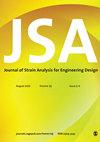Flexural analysis of second-order corrugated composite cores: Experimental, numerical, and theoretical studies
IF 1.4
4区 工程技术
Q3 ENGINEERING, MECHANICAL
Journal of Strain Analysis for Engineering Design
Pub Date : 2023-02-06
DOI:10.1177/03093247231152569
引用次数: 3
Abstract
Corrugated cores with structural hierarchy are one types of advanced cores that inspired from nature. In this work, the bending behavior of a second order, hierarchical corrugated structure has been analyzed. Experimental tests are implied to sandwich panels with both first- and second-order corrugated core by means of three-point bending test. For trapezoidal core, finite element model is provided and numerical results are validated by experimental results. Then, the validated properties are used to model sandwich panel with first- and second-order corrugated cores. To make a correct comparison, out-of-plane shear modulus of mentioned cores is calculated. Further to classical approach of ASTM7250, based on the first-order shear deformation theory (FSDT), a closed-form solution is used to predict the out-of-plane core shear modulus and compared with ASTM procedure. Results reveal that including shear deformation effects, the determined shear modulus based on FSDT is larger than classical standard procedure. Furthermore, shear modulus of second-order corrugated core is smaller than first-order one of the same relative densities.二阶波纹复合材料芯的弯曲分析:实验、数值和理论研究
具有结构层次的波纹芯是一种受自然启发的高级芯。在这项工作中,二阶,分层波纹结构的弯曲行为进行了分析。通过三点弯曲试验,对一、二级波纹芯夹芯板进行了试验试验。针对梯形岩心,建立了有限元模型,并通过实验验证了数值结果。然后,将验证的特性用于具有一阶和二阶波纹芯的夹层板的建模。为了进行正确的比较,计算了上述岩心的面外剪切模量。在ASTM7250经典方法的基础上,基于一阶剪切变形理论(FSDT),采用闭式解对岩心面外剪切模量进行了预测,并与ASTM方法进行了比较。结果表明,考虑剪切变形的影响,基于FSDT的剪切模量比经典标准方法确定的剪切模量大。在相同相对密度下,二阶波纹芯的剪切模量小于一阶波纹芯的剪切模量。
本文章由计算机程序翻译,如有差异,请以英文原文为准。
求助全文
约1分钟内获得全文
求助全文
来源期刊

Journal of Strain Analysis for Engineering Design
工程技术-材料科学:表征与测试
CiteScore
3.50
自引率
6.20%
发文量
25
审稿时长
>12 weeks
期刊介绍:
The Journal of Strain Analysis for Engineering Design provides a forum for work relating to the measurement and analysis of strain that is appropriate to engineering design and practice.
"Since launching in 1965, The Journal of Strain Analysis has been a collegiate effort, dedicated to providing exemplary service to our authors. We welcome contributions related to analytical, experimental, and numerical techniques for the analysis and/or measurement of stress and/or strain, or studies of relevant material properties and failure modes. Our international Editorial Board contains experts in all of these fields and is keen to encourage papers on novel techniques and innovative applications." Professor Eann Patterson - University of Liverpool, UK
This journal is a member of the Committee on Publication Ethics (COPE).
 求助内容:
求助内容: 应助结果提醒方式:
应助结果提醒方式:


